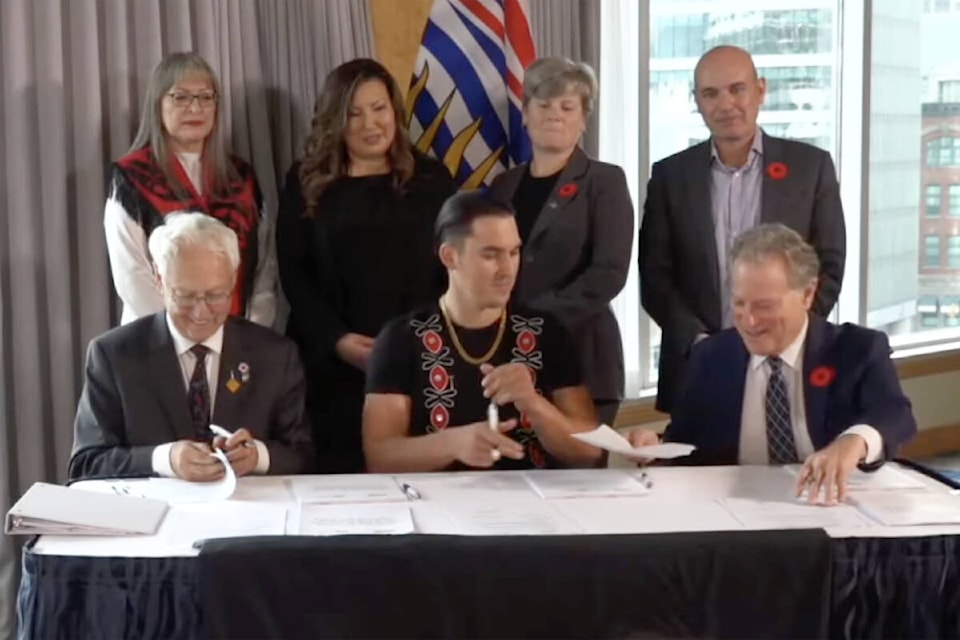For the second time, the province and the Tahltan Central Government have come to a consent agreement on a northwestern B.C. mining project.
The agreement, signed Nov. 1 in Vancouver, will allow Newcrest Mining to seek approval to vastly expand the lifespan of its Red Chris gold-copper-silver mine in B.C.’s “Golden Triangle” by developing a block-caving operation.
Under the province’s Declaration on the Rights of Indigenous Peoples Act (DRIPA) – which is based on the United Nations Declaration on the Rights of Indigenous Peoples – resource projects require the free, prior and informed consent of First Nations affected by them.
It means the environmental assessments, permitting and approvals for the mine expansion will be a collaborative effort between B.C.’s Environmental Assessment Office and the Tahltan.
“This agreement is nothing new for us as Tahltan people,” said Chad Norman Day, president of the Tahltan Central Government.
“It only affirms what we’ve known all along, which is that when there’s major development in Tahltan territory, the world, the province, industry, they require our consent. And if we’re to work together and thrive together, the province and the Tahltan Nation and industry is always going to have to come together in a respectful way to really honour and give life to the words of reconciliation.”
In 2021, B.C., the Tahltan Nation and the proponents of the Red Chris project and the Skeena Resources’ Eskay Creek project, began negotiations under Section 7 of DRIPA.
READ MORE: B.C. to begin DRIPA-based negotiations with Tahltan First Nation on two northwest mining projects
In 2022, the Eskay Creek Revitalization Project became the first consent-based agreement in history under the legislation.
According to Marie Quock, chief councillor of the Iskut band, on whose land Red Chris is situated, this agreement goes a long way toward peace of mind that the land will be protected.
“I know that our community is pleased with this agreement because we now have certainty where we didn’t before,” she said.
Environment Minister George Heyman said it is “incredibly meaningful” to see what was just an idea in 2019 when DRIPA was created come to fruition in the form of actual consent agreements.
“Through new processes that we are co-creating, the Tahltan people and the province as a whole will benefit from Tahltan stewardship of the land,” he said. “And we all benefit from these and other acts of reconciliation.”
Indigenous Relations and Reconciliation Minister Murray Rankin added that this is just the beginning.
“We’re doing this work that’s never been done before, under the auspices of a statute that’s never been done … we were the first jurisdiction in North America to do this,” he said. “I want to say it’s just the start because there’s many more relationship agreements of this sort that we are going to work on together with the Tahltan, because we’ve been able to forge such a strong partnership.”
Block-caving is a relatively new mining technique that is far more efficient than conventional underground mining making ore bodies previously deemed uneconomical for extraction more feasible.
Red Chris produced its first copper concentrate in 2015 and the lifespan of the mine was projected to be around 28 years.
In 2019, the Australian gold-mining giant Newcrest acquired a 70-per-cent stake in the operation in a joint-venture with Imperial Metals. Shortly thereafter, it began a pre-feasibility study for the block-cave operation.
Estimates currently peg the new resource at approximately 480 million tonnes. The company intends to process approximately 12.8 million tonnes per year, which would extend the mine life by 31 years.
Newcrest expects the expansion to cost $2.6 billion with a payback on the investment within 3.2 years.
READ MORE: Prefeasibility study extends northwest B.C. gold mine life by 30 years
Editor’s note: A previous version of this story unintentionally implied the agreement was approval for the block cave operation, rather than the ability to seek approval.
thom.barker@blackpress.ca
Like us on Facebook and follow us on Twitter
